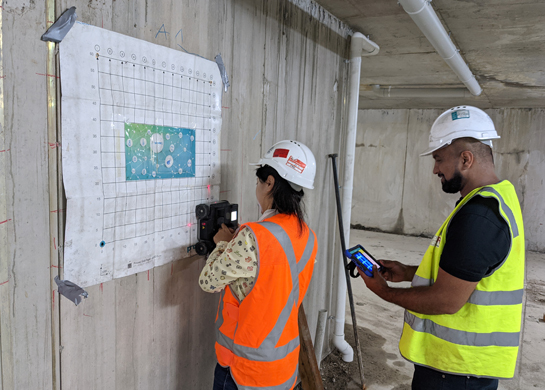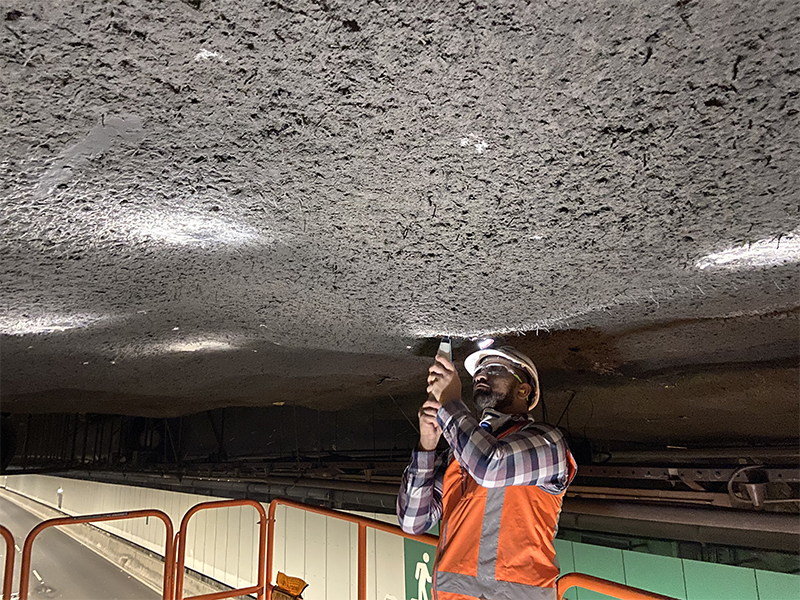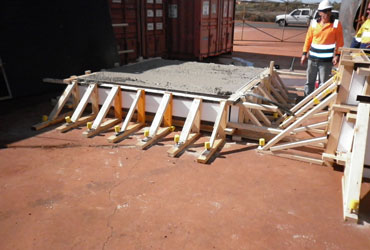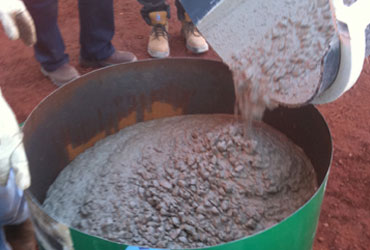With a reputation for pioneering techniques to detect corrosion and model deterioration mechanisms, BCRC uses Non-Destructive Testing (NDT) tools and techniques to assess the condition of reinforced structures. This helps identify damage and severity of defects, thickness of concrete members, and the presence and rate of corrosion, as well as the long-term impact on serviceability.

Concrete Testing
BCRC’s consultants have been involved in the use and development of Non Destructive Testing (NDT) for over 30 years. Frank Papworth commenced his involvement with NDT in 1978 when he managed one of the UK government sponsored programmes in ‘Concrete in the Oceans’ to assess the performance of marine structures. It included some of the first assessments of NDT’s for corrosion measurements including electrical potentials, linear polarisations and resistivity measurements on concrete. Other research projects included these tests and NDT for quality of concrete including Ultrasonic Pulse Velocity (UPV) and Gamma Ray Backscatter. Since 2002 BCRC’s Frank Papworth has focused on seeking out the world best practice in NDT of reinforced concrete structures and, through his company PCTE. this has led to the introduction of many new techniques in Australia.
Non-Destructive Testing (NDT)
BCRC have been at the forefront of introducing new NDT methods to Australia for over 30 years. In the early 80’s Frank Papworth bought to Australia the corrosion assessment techniques he had helped research and develop in the UK. These included electrical potential measurements, concrete resistivity measurement. In the mid-80’s he was able to bring to Australia the first electrical potential wheel, an instrument he masterminded in the UK for rapid scanning of the corrosion risk. Over the last 10 years he has introduced a broad range of methods including Olsons instruments geotechnical methods, the MIRA 48 transmitter receiver UPE ‘body scanner’ for concrete.
BCRC today have a wide range of NDT methods at their disposal. Ultrasonic Pulse Echo (UPE), Impact Echo (IE), Impulse Response (IR), Cross Hole Sonic Logging (CHSL) and Ground Penetrating Radar (GPR) are advanced Non-Destructive Test (NDT) methods for evaluation of concrete structures. In each case, stress waves or electromagnetic waves are introduced into the concrete and reflected waves or structure responses are measured.
These methods have seen rapid development and acceptance in many countries in Europe, North America and Singapore. All are now used in Australia but not commonly. Use has sometimes been stimulated by legislation requiring assessment of structures at regular intervals. Other advanced techniques such as Spectral Analysis of Surface Waves (SASW) and Interferometric Radar are having less impact in Australia because they have specific application where the market has yet to appreciate the benefits. Added to these there are a wide range of commonly used NDT’s in Australia such as Rebound Hammer, UPV, Humidity Probes, Temperature and Maturity, Electrical Potentials, Polarisation Resistance and Pulsed Eddy Current Covermeter.
For the last 5 years there is a new focus on development of monitoring systems. Strain and displacement gauges have been used for many years but today emphasis is on corrosion monitoring and systems that can be used for remote monitoring.
BCRC today have a wide range of below stated NDT methods & techniques at their disposal:
| NDT equipment & techniques | Purpose |
| Ground penetrating radar (GPR) | Reinforcement configuration, large voiding, element thickness |
| Impact echo (IE) | Concrete thickness, quality, void detection |
| Ultrasonic pulse echo (UPE) | Concrete thickness, void detection, quality, voids in PT ducts |
| Ultrasonic pule velocity (UPV) | Quality, uniformity, crack depth measurement, compaction, elastic modulus |
| Spectral analysis of surface waves (SASW) | Void detection, crack depth, profile layered material, detect voids in PT ducts |
| Corromap | Half-cell potential, corrosion- risk, corrosion, rate, large areas |
| Resipod | Electrical resistivity of concrete, potential difference, corrosion risk |
| Sonic echo/ impulse response | Pile depth, footing dimensions, piles concrete quality and integrity |
| Covermeter | Concrete cover, reinforcement layout, GPR calibration |
| Schmidt hammer | Concrete quality, surface harness, indicative compressive strength |
| Infrared thermography | Defects in permanent formwork, delaminated render, coating, moisture |
| Strain gauging | Monitoring, loading, post tensioning, bridges |
| Ultrasonic thickness (UT) | Thickness measurement – Steel, coating, membrane, waterproofing |
Non Destructive Testing (NDT) is a valuable tool in assessing the condition of existing reinforced structures, after visual inspection NDT can identify the rate of damage, the severity of the issue, its location and extent of defects, thickness of concrete members , presence and rate of corrosion activity. A well-chosen combination of techniques contributes to improved assessment of the structure; BCRC have the unique ability to provide expert input from durability, concrete, inspection and repair specialists.
Our staff have over 30 years’ experience in testing steel reinforced concrete structures. From visual inspections, aerial inspections, crack mapping, strength investigations and cover surveys to Ground Penetrating Radar (GPR), Ultrasonic Pulse Velocity (UPV), Ultrasonic Pulse Echo (UPE), Impact Echo (IE), Impulse Response (IR), Spectral Analysis of Surface Waves (SASW), Resistivity and Half Cell Potential (HCP) surveys a BCRC representative is always available to help plan your next structural investigation.
Laboratory Tests
BCRC’s consultants have expertise in most laboratory tests for concrete.
From the standard strength and shrinkage tests BCRC have a history in speciality testing. BCRC’s Managing Consultants have a long history in laboratory testing both from the standard commercial concrete performance tests to specific durability tests.
Fresh Concrete Tests
Bob Munn has been at the forefront of developments in fresh concrete properties. As the technical director for Boral he took overall responsibility for concrete testing of concrete supply for over 20 years.





